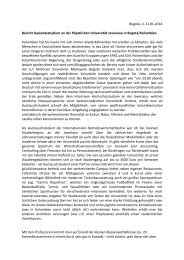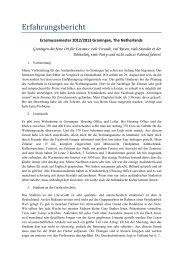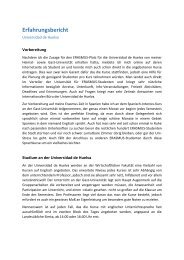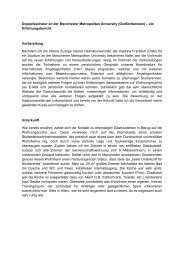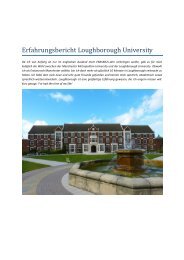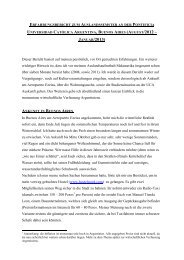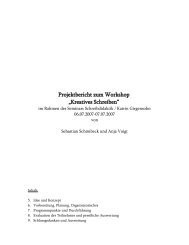Dariusz Aleksandrowicz Aleksandrowicz - Europa-Universität ...
Dariusz Aleksandrowicz Aleksandrowicz - Europa-Universität ...
Dariusz Aleksandrowicz Aleksandrowicz - Europa-Universität ...
Create successful ePaper yourself
Turn your PDF publications into a flip-book with our unique Google optimized e-Paper software.
Frankfurter Institut für<br />
Transformationsstudien<br />
Frankfurt institute for<br />
Transformation Studies<br />
Arbeitsberichte - Discussion Papers<br />
ISSN 1431- 0708<br />
Herausgeber - Editorial Board<br />
Prof. Dr. J.C. Joerden<br />
Prof. Dr. H-J. Wagener<br />
© by the author<br />
<strong>Dariusz</strong> <strong>Aleksandrowicz</strong><br />
The Socialist City and its<br />
Transformation<br />
No. 10/99<br />
<strong>Europa</strong>-<strong>Universität</strong> Viadrina<br />
Postfach 1786<br />
D - 15207 Frankfurt (Oder)
<strong>Dariusz</strong> ALEKSANDROWICZ<br />
The Socialist City and its Transformation<br />
Prof. Dr. <strong>Dariusz</strong> <strong>Aleksandrowicz</strong> is professor for philosophy, especially philosophical<br />
basics of cultural science analysis at the European University Viadrina, Frankfurt (Oder)<br />
and a member of the F.I.T. The F.I.T. is supported by the Deutsche Forschungsgemein<br />
schaft (DFG) as innovation college.
The Socialist City and its Transformation<br />
I. Ideological foundations of a socialist city<br />
Unlike the development of new cities in Western industrial countries, the rise of socialist<br />
cities cannot be explained in terms of economic objectives and economic<br />
growth in the usual meaning of the word. The very rationality of the communist system<br />
was not an “economic” one but rested upon subordinating the latter to objectives<br />
which derived their justification from communist ideology. Achieving these ideology-defined<br />
tasks was due much more to political decision and political activity than<br />
to the organic development of the society and its infrastructure. The intention consisted<br />
rather in creating some new reality which would contradict the “spontaneous”<br />
(i. e. mainly economically determined) dynamics of the social organism. 1 Although<br />
the communist vocabulary contained words like “economic” or “economy”, what<br />
they referred to was, however, a politically manipulated system of production and<br />
distribution. 2 In the proper sense “economy” means the type of rules which govern<br />
production and distribution of goods. In Communism, on the contrary, the notion attributed<br />
to the specific content of what is being done (i. e., creating material goods),<br />
whereas the rules appropriate to it relied on political decision and ideological legitimization.<br />
Conceiving the city as the major scene where the communist utopia was to be realized<br />
in people’s every-day life, the Soviet-type Communists were in line with the<br />
mainstream of the tradition of utopianism. It was represented, for instance, by the<br />
“New Jerusalem” in the Apocalypse of John or by Campanella’s “The City of the<br />
Sun.” In accordance with this tradition they regarded the city as the expected surrounding<br />
where the new world resulting from a radical change would find its ex<br />
pression. 3 The ideology of the Soviet-type Communists differed here from their<br />
1 For the opposition of “spontaneous” and “constructed” order cf. Hayek (1978: ch. 6). With<br />
respect to the problems of a “socialist city” – cf. Szczepañski (1990; 1993a: 63p.). Contrasting<br />
“spontaneous” social order with the communist attempt to “construct” a society according to a<br />
general plan laid down by the superior political authority, we must, however, avoid possible misinterpretations.<br />
The communist idea of planning (or: planned economy) as a principle of social<br />
organization is not to be confused with planning (especially: urban planning) as a method of rationally<br />
managing and mutually adjusting particular aspects of a social organism. Since “planning”<br />
in the first meaning can be opposed to “spontaneity”, as Hayek understands the term, the<br />
proper opposite to “planning” in the other sense would be “anarchy”. For a related distinction<br />
between “utopian planning” and “social technology of particular problems” cf. Popper (1945: ch.<br />
9).<br />
2 The idea of opposing “production” and “economy” in order to finally release production of material<br />
goods from restrictions imposed upon them by economic rules traces back beyond Marx’<br />
“Critique of Political Economy” to the writings of Saint-Simon. For more cf. <strong>Aleksandrowicz</strong><br />
(1993: ch. XI) and Polanyi (1960).<br />
3 “From the architectural utopias of Alberti and Leonardo in the Renaissance, to Le Corbusier’s<br />
design for the ‘city of tomorrow,’ architects and urban planners have sought to realize the good
2 F.I.T. Discussion Paper 10/99<br />
Maoist or Red-Khmer counterpart, who thought the village and not the city to be the<br />
genuine environment of the desired mode of life.<br />
Looking from a historical perspective, we must, however, realize that the relation<br />
between the city and the village in both ideology and practice of the Soviet Communism<br />
appears a little more complex. Prior to the Bolshevik revolution as well as in<br />
the initial period of Soviet Russia, when a competition between different utopian<br />
designs took place, the “urbanist” models were challenged by the “disurbanist” ones<br />
(cf. Stites, 1989: 30p. and ch. 9). The latter originated from these currents of the<br />
Russian culture which claimed the native tradition roots in the rural mode of life and<br />
is to be regarded as superior to urban tradition coming from the West. On the other<br />
hand, the Marxists, both in Russia and in the West, always insisted on the elimination<br />
of the differences between the city and the village as a prominent objective of a<br />
communist society. Although these hopes were never fulfilled in the reality and the<br />
“urbanist” current finally dominated the opposite one, the Soviet-type socialist cities<br />
were as little “urban” as the Soviet villages populated by the workers of the collective<br />
farms maintained their “rural” character. In the social and spatial structures represented<br />
by these both types of environment, the city and the village lost much of the<br />
features traditionally ascribed to them.<br />
According to its design, a socialist city was intended to be something more than a<br />
mere town-planning and architectonic creation. It implied moreover the respective<br />
new style of living and a Weltanschauung, which resulted from an utopian view of<br />
the future world and of man. The design of really-existing Soviet-type socialist cities<br />
as well as purely theoretical projects developed by the Western-European (especially<br />
French) socialist city planers were based on such ideas. According to Tony<br />
Garnier’s design of a “Cité industrielle,” the new city would be a model of the desired<br />
future, contributing by its example to the rejection of the traditional forms of<br />
society and of life (cf. de Bruyn, 1992; Garnier, 1988). These Western-type collectivist<br />
ideas have later found their ultimate expression in the so-called “Charter of<br />
Athens.” (cf. Le Corbusier, 1957).<br />
Due to the very philosophy of a socialist city, its empirically given reality was, as it<br />
were, complemented by the image of some future, emerging state of things<br />
the name of which was “Communism.” The town-planning and architectonic features<br />
of the city were therefore to be viewed with respect to their conformity with the<br />
imaginary, future “man of Communism.” An important function of the city consisted<br />
in contributing this “new man” (now existing only as an ideological project)<br />
to really emerge. Together with the usual means of education and political propaganda,<br />
the city had to approximate this task by way of imposing upon its inhabitants<br />
some special behavioural patterns and style of life. This was to result from the<br />
life in the bricks of buildings and the grids of squares and streets. ... The ideal city contributes the<br />
element of design. Its premise is that the good society must be constructed, thought through in a<br />
systematic way. Its hallmark is reason, its emblem the plan.” Kumar (1991: 14, 19).
D. <strong>Aleksandrowicz</strong>: The Socialist City and its Transformation 3<br />
spatial order represented by the city as well as from the specific visual experience<br />
permanently offered in it.<br />
In the history of Communism and its ideology, however, the historicist metaphysics<br />
which originally formed the core of the respective ideas was gradually dwarfed by<br />
interpretations suggested by a more pragmatic assessment of problems in the light of<br />
realpolitik. 4 Although the crucial notions such as “Communism,” which referred to<br />
the desired model of society, still could not be understood without taking into account<br />
the revolutionary eschatology they were originally rooted in, they at the same<br />
time acquired a more practical and concrete meaning. It was most of all Stalinism<br />
that succeeded in pushing the idea and the practice of Communism away from the<br />
purely abstract notions once developed in Marxism. The chief invention of Stalinism<br />
was in this respect to establish “industrialization” as a secular equivalent of the<br />
metaphysical idea of “emergence of Communism.”<br />
Industrialization and creation and/or further development of the working class were<br />
therefore the major “practical” objectives to which the socialist cities owed its existence.<br />
Since we can speak about both “industrialization” and “working class” also<br />
with regard to the Western society, it is important to note the specific “socialist”<br />
meaning of these terms due to the specific features of the reality to which they refer.<br />
“Industrialization” here chiefly means the construction of production plants (especially<br />
in the domain of heavy industry). The function of these plants was to employ<br />
people and to produce things according to directives resulting from the politicallydefined<br />
production plan. Apart from some physical or even technological similarity,<br />
the socialist “production plant” had little in common with the “enterprise” in the<br />
economic sense of the word. Correspondingly, the socialist working class, unlike the<br />
class of employees in a Western society, owed its very existence not to the economic<br />
process, and its position was not determined by what was taking place on the market.<br />
More significant was its relation to the socialist state. It was exactly the socialist<br />
state and not the market that created and secured the place of work, determined the<br />
conditions of work and of life, and defined the system of duties and privileges for the<br />
members of the working class. 5<br />
II. Specific features of a socialist city<br />
Socialist cities or settlements of the Stalinist period and those of the later decades<br />
differ architectonically from each other. The first of them were usually built in a<br />
socialist “neo-classical” style with socialist “baroque” elements added to it,<br />
whereas the simplistic architecture of the latter was determined by technology of the<br />
pre-cast panels. What they have in common is, however, an egalitarian, anti-<br />
4 For more cf. <strong>Aleksandrowicz</strong> (1989).<br />
5 For more cf. <strong>Aleksandrowicz</strong> (1993a; 1998a)
4 F.I.T. Discussion Paper 10/99<br />
individualistic monotony of the urban space. 6 The human individual as an inhabitant<br />
of the city was confronted by the urban space in the same manner as he/she was confronted<br />
by the institutions of the socialist state. He/she was integrated into a spatial<br />
order which widely determined his/her behaviour, leaving him/her very few alternatives<br />
to use the urban space as a field of his/her individual creativeness. This determination<br />
manifested itself in everyday-life – with respect to both the individual’s<br />
work and leisure-time – as well as in the specific forms of public activity which was<br />
organized within and by way of the structures of the urban space.<br />
In the traditional (“bourgeois”) city which has developed owing to the economic<br />
process, the centre of the town is obviously marked by mercantile factors. “Centre”<br />
means there above all “shopping –“ and “business centre.” The aim of the socialist<br />
city planers was in turn to give the centre of the new city an ideological character.<br />
That is, instead by the market-place the centre of the town was here to be organized<br />
by political institutions and by official ideology. 7 This very idea was, for instance,<br />
the background of the reconstruction of Bucharest at the time of the late Ceausescu -<br />
a project which can be interpreted as an effort to make a socialist new city out of a<br />
traditional one.<br />
Except obvious similarities there are also differences between the socialist and the<br />
“pre-bourgeois” concept of the centre of a city. In the latter, the principal area was<br />
defined as a centre of religious cult and of administration. The socialist city, in turn,<br />
tended to marginalize religion and to somehow substitute it by secular ideology.<br />
What added here to the administrative function of political power were, among others,<br />
its manipulative and mobilizing efforts attempting the masses of inhabitants to<br />
act in a particular way within the spatial order of the city. But still good arguments<br />
could probably be found to support the thesis that something similar occurred also in<br />
at leas few representative cities of the absolute monarchies.<br />
According to the concept of a socialist city, the centre was to be defined as the space<br />
where some specific form of collective life of the inhabitants of the city takes place.<br />
By its very nature, it was an ideologically controlled collective life. A particular<br />
political directive or a regular official occasion, such as a state or party festival,<br />
were the source of activity which tentatively united the passive and isolated<br />
6 Some substantial ideas underlying the design of a city in a communist-type society are, however,<br />
not of Stalinst origin, but can be traced back to the early writings of the founders of Communism.<br />
This refers especially to the concept of dwellings which were intended to promote a “collectivist<br />
way of life.” 1847 Engels pleaded for “construction, on public lands, of great palaces as communal<br />
dwellings for associated groups of citizens engaged in both industry and agriculture.” Engels<br />
(1847).<br />
7 Cf. Kotarbiñski (1985: 54): “... the city should have a centre of a social and political type as well<br />
as squares and streets as the space of collective life.” Szczepañski (1993b: 152), suggests an<br />
analogy between socialist and “oriental” concept of the centre of a city. According to Szczepañski,<br />
the common feature shared by them is emptiness of one part of the central space with the<br />
other part occupied by monumental buildings.
D. <strong>Aleksandrowicz</strong>: The Socialist City and its Transformation 5<br />
“socialist people” into an active whole which had to play a special role within the<br />
ideologically determined ritual.<br />
Besides the political centre, another dominant factor of a socialist city was the production<br />
plant. Many new socialist cities have been built for the staff of a single large<br />
production plant or for a single branch of heavy industry. 8 The role the production<br />
plant played in the life of a socialist city went far beyond the process of production<br />
and of work. Because of the permanent supply shortages, the plant provided the supply<br />
of commodities for the members of its staff. 9 It also provided cultural life for<br />
them and kindergarten for their children. Holidays were organized by the production<br />
plant in the plant-owned “recreation settlements.” Despite the fact that these settlements<br />
were geographically distant from both socialist city and socialist production<br />
plant they belonged to the very same context and were thus an extension of the behavioural<br />
and cultural patterns determined by it.<br />
The new socialist city essentially consisted of (1) the centre of political and ideological<br />
manipulation, (2) the place of production and of work, and (3) the private<br />
dwelling-place. In each of these specific spaces the individual was dominated by<br />
political manipulation (which was daily present at least in form of visual propaganda<br />
and of monumental architecture of the central square or of the official buildings),<br />
by the plant, and by the anonymity and monotony of the living blocks. As a<br />
result of an extremely poor infrastructure of the urban-specific services (including<br />
cultural services) there existed hardly any mediating instances between the individual<br />
space, which was reduced to the inside of the dwelling-place, and the public<br />
space of the city, which was the spatial representation of the authority of the socialist<br />
state. This type of relation between the individual and the collective (or:<br />
between the private and the public) was, to be sure, also an essential issue in the<br />
above mentioned ideas of the Western socialist city planers. In Garnier’s design of<br />
the cité industrielle, for instance, “it is only the threshold of one’s own house which<br />
(...) marks the very narrow border between the privacy of living and the public<br />
space. Crossing the threshold one already finds himself outside, in a space that belongs<br />
to everyone.” (de Bruyn, 1992: 537). In the actual socialist city the problem,<br />
however, was that this space which was originally designed so as to belong to eve-<br />
8 The process of construction and of existence of a socialist city in its function as a dwelling place<br />
of one single production plant is impressively documented in Beier (1997). (The central issue of<br />
the volume is, however, to demonstrate similarities between a planned city in East and in West<br />
Germany: Stalinstadt/Eisenhüttenstadt and Stadt des KdF-Wagens/Wolfsburg. I do not deal with<br />
the related questions in this paper, because it would imply an detailed discussion of some other<br />
complex problems. One of them would be the relation between the respective aspects of the two<br />
totalitarian systems: Communism and National Socialism. It is due to the fact that Wolfsburg<br />
owes its very character as a “planned city” to its origin in the industrializing and city-planning<br />
concepts of the Nazi state.)<br />
9 From the end of the 70‘s onwards, when the crisis of the socialist economy consequently approximated<br />
its peak, some of the industrial production plants in socialist Poland even started<br />
breeding pigs in order to improve their respective services. These initiatives were glorified by the<br />
media and supported by the officials of party and state.
6 F.I.T. Discussion Paper 10/99<br />
ryone, was in fact a no-one’s space. It was due to the failure of the original task of<br />
socialism to make a “new” man out of the “old” one, for whom the very distinction<br />
between the “private” and the “public” wouldn’t exist anymore.<br />
III. Idea and reality of a socialist city: remarks on Naberezhnye Chelny<br />
Like all other institutions of a socialist society, socialist cities have developed in the<br />
context of a tension between the ideology-conforming design and the given reality.<br />
What the city in effect was like as well as the very dynamics of its development,<br />
were at least as much due to the original assumptions of the plan as to a tentative<br />
adjustment of contradicting factors. 10 In “non-reforming” countries, like Russia, as<br />
well as in the “reforming” 11 ones some determinants of this type of dynamics survived<br />
the disintegration of the institutional system of Communism. There are, however,<br />
some crucial differences between the respective processes which are at work<br />
in both of them.<br />
Naberezhnye Chelny (1982-1988: Brezhnev, in Tatar: Jar Chally), a city in the<br />
Autonomous Republic of Tatarstan within the Russian Federation, is one of world’s<br />
best examples of a socialist “new city.” It is a city of over half a million inhabitants<br />
the construction of which has started only three decades ago. It therefore owes its<br />
existence to a voluntary design of Soviet politicians and city planers of the Brezhnev<br />
period.<br />
The city has been planned and built along with the “Kamaz” production plant, which<br />
– according to its size and output measured in tons and numbers – once was the biggest<br />
truck factory in the world. Like in any other model socialist city, the very functioning<br />
of the urban organism of Naberezhnye Chelny as well as its inhabitants’ conditions<br />
of life depend upon the plant. But this dependence here is much more substantial<br />
than it was the case in a Central European socialist city. This is because of<br />
the dimensions of both the city and the plant and due to the geographical distance that<br />
separates Naberezhnye Chelny from other industrialized areas.<br />
After the collapse of the communist system in Russia, the dominant role of the<br />
plant did not disappear but it adopted new forms. What one was now confronted<br />
10 I’m not dealing here with the question as to how far several types of adaptive spontaneity of this<br />
kind simply promoted functional disorder and degenerated into anarchy. For analyses of related<br />
issues cf. Wódz (1990).<br />
11 By “reforming countries” I mean the so-called “Visehrad” and Baltic countries, and Slovenia.<br />
They follow the course of post-communist transformation which consists, roughly speaking, in<br />
approximating the “Western” model of democracy and market economy. Contrasting these<br />
countries with the “non-reforming” ones, I ignore the question as to whether it would make sense<br />
to differentiate some intermediate cases. The examples for “non-reforming” countries can especially<br />
be found in much of the post-Soviet spectrum.
D. <strong>Aleksandrowicz</strong>: The Socialist City and its Transformation 7<br />
with was a continuation of the respective relation between the plant and the city in<br />
the changed situation of the post-communist period. At that time, that is at the begin<br />
of 90’s, all of the best land around Naberezhnye Chelny belonged to Kamaz. The<br />
plant has bought this land from the surrounding collective and state-owned farms -<br />
the kolkhozes and the sovkhozes. Kamaz has exercised political influence to move<br />
the farms to sell the land, despite of the resistance of their staff “Kamaz is an empire,<br />
it can exercise power.” 12 The chief argument in the bargaining could in turn be easily<br />
used as a purely ideological one. It referred to the needs of the workers of Kamaz<br />
who are looking for new houses to be built – a slogan which was impressive for<br />
minds that grown up on ideas once promoted by the communists. 13<br />
Unlike the conditions of the Soviet society, there are now some capitalist elements<br />
that determine the situation of the involved actors. Among others, it is land property<br />
(although there is still no genuine private land property) as an important factor in the<br />
context of the economic game. Methods used by the plant to improve its position in<br />
the new context, however, follow from the old repertoire. They consist in political<br />
pressure and ideological argumentation. It is therefore still the standing of the actors<br />
within the distribution of political power that decisively influences the results of this<br />
special type of competition. 14<br />
The respective evolution, the core of which is the specific constellation of economic<br />
and of political factors, occurred also within Kamaz itself. The former socialist<br />
“production plant” acquired some features of an “enterprise” and it became divided<br />
into what in Poland is being called “nomenclatura joint-stock companies.” This is a<br />
special type of organization of an enterprise in the transitory period that in a peculiar<br />
way combines politics and economy. The semi-owners of the companies<br />
usually come from the ranks of the former members of the communist nomenclatura 15<br />
(usually of the leadership of the respective plant). In post-communist Russia, there<br />
are hardly the rules of the market that form the framework of the nation-wide economic<br />
process. Therefore, individuals involved into networks emerging from the<br />
system of the nomenclatura are in a position to implement the political means at<br />
their disposal in order to approach economic objectives. At the same time, they<br />
12<br />
Unauthorized record of an interview with Director of Kamaz Incorporated Design and Production<br />
Company Nilov W. Stepanovitsh. The interview was organized by Peter Marcuse at September<br />
15th 1993. At the interview participated except Marcuse and myself also Amine Benaissa,<br />
James Hansen and Alastir McAuley.<br />
13<br />
In fact, building of dwelling place for workers has been at that time drastically reduced as compared<br />
with the communist period.<br />
14<br />
Also the question as to whom - to the city or the plant - should the biggest hotel in the town<br />
belong, was to be answered according to the very same mechanism. It was to be decided by way of<br />
political power-play and not, for instance, with respect to some legally defined procedure.<br />
15<br />
The term was originally used in the official Soviet language. It referred to all positions in the<br />
system for the performance of which the individual was to be “named” by the executive of the<br />
Communist Party at the respective level of Party’s hierarchy. It gained then international and<br />
theoretical relevance owing to the book of Voslensky (1980).
8 F.I.T. Discussion Paper 10/99<br />
are not seriously burdened by capital risk or by competition in the proper sense of<br />
the word.<br />
In the way the system functions now we can, however, see an evolution of the very<br />
same logic that determined the functioning of the respective aspects of the communist<br />
society. In Communism there were the political rules of the game that substituted the<br />
economic ones and finally resulted in creating “economic” factors in the Soviet<br />
meaning of this term. It was due to political influence that the decision was taken to<br />
build up the plant at this or other place, to direct the respective amount of resources<br />
for its creation and subsequent growth, to secure its monopolistic position etc. Control<br />
over these “economic” factors gave then the possibility to translate them into<br />
means of political power and superiority. The latter were in turn instruments by the<br />
virtue of which particular economic advantages could be gained.<br />
Kamaz trucks were a desired commodity, but they were (because of the character of<br />
the Soviet economy as an “economy of shortage” (cf. Kornai, 1980)) hard to buy.<br />
The other cities – respectively plants that dominated them - got the trucks if they accepted<br />
to give in exchange the pre-cast panels that were originally destined for their<br />
own house-building programs. Owing to this, Naberezhnye Chelny could grow faster<br />
that most other cities in the country (Stepanovitsh). This illustrates the way of attaining<br />
economic objectives in a context determined by a primarily “non-economic”<br />
type of behavioural rationality.<br />
As in any other socialist city, the original idea that underlaid the plan to be realized<br />
in the pre-cast-panels landscape of Naberezhnye Chelny was to come as close as<br />
possible to the ideal, i.e. to the communist ideal. The people thus participated in the<br />
building activity, “building settlements for others, not only for themselves,” and were<br />
proud to say: “it was field - now it is city!” (Stepanovitsh) There was a clear educational<br />
component in it, connected with the task of bringing up the collectivist “man of<br />
Communism.” For, according to the very core of the Soviet ideology, it was first of<br />
all the building activity where this “new man” was expected to emerge from (<strong>Aleksandrowicz</strong>,<br />
1993b: 89 - 93).<br />
Still, there were not only such purely utopian aspects of the plan that were not fulfilled<br />
in reality. Due to the scheme once accepted, the centre of Naberezhnye<br />
Chelny was planed at the geographical centre of the city. There should be a circus,<br />
cultural objects, supermarkets, and a market place. 16 The project in some respect<br />
intended to approximate the model of Brasilia – a city voluntarily designed and<br />
erected in the wilderness of the Brazilian interior. But the plan was never realized. 17<br />
16 The town hall, however, was not intended to be a part of it. The town hall as well as the city<br />
council located in it didn’t have any serious function to perform in the Soviet system, since it was<br />
substituted by the municipal committee of the Communist Party.<br />
17 The same, as reported by Stepanovitsh, happened to the originally planed sport centre. Due to the<br />
pressure of the party leaders who wished to have the respective facilities in their neighbourhood
D. <strong>Aleksandrowicz</strong>: The Socialist City and its Transformation 9<br />
“We still do not have a centre, since the design of the centre turned out to be very<br />
expensive. It therefore extended the available means. Besides that, we simply lacked<br />
technical possibilities to realize it. It should be the task of future - when we will<br />
have more means to make it even better and perfect.” 18 The other reason why the<br />
centre hasn’t been constructed, however, was, according to Stepanovitsh, the lack of<br />
real demand. Priority, therefore, was given to dwelling space. “You see, the city can<br />
exist and function well without a centre. You in fact don’t need any such centre in the<br />
usual practice which takes place in the space determined by the objectives of working,<br />
shopping and living.” (Stepanovitsh).<br />
Looking at the issue in the light of strategies social actors implement in order to<br />
adapt to the existing reality, there are, I think, the following conclusions which can<br />
be derived from it: On the one hand, what we face here is, as it were, a “reverse<br />
adaptation”; that is, adaptation of a somehow sophisticated project to the very norm<br />
of Communism. According to the logic of the system as expressed in the urban space,<br />
there was no reason for such a centre to be really constructed. On the other hand, we<br />
can speak here of adaptation to the provisory reality determined by the failure to<br />
realize the plan. The adaptation concerns both behaviour and mentality as well as<br />
related rationalizing schemes of ideology, and with it – the planning authority itself<br />
which now attempts to interpret the failure in terms of pragmatically correcting the<br />
plan.<br />
The original project in question reflected the nature of Communism, as far as it<br />
turned out to be an imaginary state of things, never to approximate in reality. What<br />
the reality of Communism in fact was like, was a more or less chaotic building site<br />
with all the provisional and imperfect arrangements common to it. As long as the<br />
institutional and ideal framework of Communism persisted, the building site, however,<br />
had some “meaning” referring to what was intended to develop out of it. This<br />
very reference at the same time contributed to somehow “transcending” all the misery<br />
of what actually existed. In this respect, it was just like any ordinary building<br />
site, where we relativize the imperfectness or even ugliness of what is now given<br />
by relating it to the final result as presented in the underlying design. When the image<br />
of an expected future finally disappears, the sole reality one faces and lives in is<br />
reduced to the actually existing misery of provisory arrangements. The type of<br />
adaptation we face here, mainly consists in considering the conditions that resulted<br />
from the failure of the previous illusions as stable reference points for the practice of<br />
life. To be sure, this attitude is more rational than commitment to the communist<br />
myth. But it is a very poor base for a creative evolution.<br />
the original plan was abandoned. In effect, huge swimming pools were constructed in a part of the<br />
city where there live only few people.<br />
18 Stepanovitsh. Admittedly, the “failure to create a centre”, as referred to in Szczepañski (1993b:<br />
153), was not restricted to Russia, but was an usual feature of new “socialist cities” in the Soviet<br />
bloc. Cf. also Szczepañski (1990: 52).
10 F.I.T. Discussion Paper 10/99<br />
In the case discussed, the major adapting actor is the planer respectively the planning<br />
authority. Their adaptive efforts are due to giving up the original plan and at the same<br />
to explaining the retreat by way of some new interpretative scheme. The imperfectness<br />
of what is given appears now as what the people in their ordinary lives “really<br />
need.” The “people” in question as well as the patterns of “ordinary live” and of<br />
“needs” specific to them do, however, not represent any universal anthropological<br />
standard. The respective features are but habitual consequences of the type of existence<br />
in the peculiar environment of an ill-concepted “socialist city.” But as far as<br />
the modernized views of the planers are concerned, the respective habits are about to<br />
substitute the usual standards of urban life.<br />
After the collapse of the communist system there emerged, however, some new ideas<br />
as to how the future centre of the city is to be constructed. What the ideas substantially<br />
aimed at was to change and at the same time to re-introduce the communist<br />
concept of a centre as a “centre of power” according to what “power” in the altered<br />
situation means. The two key objects designated for the new centre were therefore a<br />
business centre of the Kamaz “nomenclatura joint stock companies” and, close to it,<br />
an impressive building of the American-Russian Fund Dialogue Inc. 19 The huge dimensions<br />
of both of them is exactly what the image of the centre is to be expressed<br />
by.<br />
IV. Transformation of a socialist city: constructive and destructive adaptation<br />
The very design of the new socialist city followed the ideal of a plan- and ideologyconforming<br />
society which had to overcome the spontaneous social process based on<br />
individual activity. The adaptive counter-tendencies which resulted from behavioural<br />
strategies of individuals and groups, however, as already mentioned in the<br />
previous chapter, consisted in changing the original functional order and the<br />
image of the socialist city according to the spontaneous forces and needs. This adaptation<br />
took place long before both the breakdown of the communist system 20 and<br />
19 Despite of the practical function of it – that is, selling software - there was also some ideological<br />
justification for the Russian-American joint venture to be part of the institutional as well as<br />
symbolic centre of the city. As far as we can speak of “Westernization” with respect to the postcommunist<br />
Russia, this word would there especially mean a superficial “Americanization”, without<br />
any deep reference to respective institutional re-arrangements or people’s behavioural patterns.<br />
(It may be an accidental illustration of this problem that during the interview mentioned<br />
above Stepanovitsh exposed on his desk a few two-years old issues of “New York Post” to<br />
document that he once had “unforgettable luck” to be there.)<br />
20 Socialist cities, to be sure, finally owed their real character at least as much to the ideological<br />
design as to the efforts of the local apparatshiks to adapt it to the particular interests rationally<br />
defined by them. It was, for instance, in accordance with these interests to have the biggest possible<br />
production plant in one’s own sphere of influence and to guarantee as much as possible resources<br />
to be planned for it. For the general problem of correlation between objectives of the<br />
plan and particular interests of the apparatshiks cf. Hoessli (1989: 54p.): “Bürokratie gegen
D. <strong>Aleksandrowicz</strong>: The Socialist City and its Transformation 11<br />
the implementation of reformist policies in some of the former communist countries.<br />
But it became more dramatic after that event, since the institutional framework, on<br />
which the rationality of the socialist city was hitherto based, ceased to exist. For the<br />
sake of this analysis, we can differentiate two general types of such adaptation: the<br />
constructive and the destructive one. Both of them are of crucial importance for the<br />
future prospects of these specific urban environments. 21<br />
One of such adaptations we could observe was the shift or the functional change of<br />
the centre of the socialist city. The design-conforming city centre as an “ideological<br />
centre” did not correspond with the real life of the inhabitants. It was rather an area<br />
where they were expected to perform some ritual behaviour which was alien to attitudes<br />
and needs defined by their every-day practice. Owing to this, the architectonic<br />
and town-planning structure of the socialist city in fact lacked any “centre” in the<br />
usual meaning of this word. The adaptive behaviour, on the other hand, resulted in<br />
creating what may be called a “moving” or “tentative” centre of the socialist city.<br />
The criteria upon which the creation of such centre rested were not ideological but<br />
economic - in the specific meaning, to be sure, in which economic problems manifested<br />
themselves in the context of the communist society. According to Szczepañskis<br />
investigations on the new socialist city Tychy in Upper Silesia, such “centre emerges<br />
irrespective of the time of the day and the day of the week, and its necessary condition<br />
is presence, or merely the expectation of presence, of attractive commodities.” 22<br />
This adaptive tendency was continued after the collapse of the communist system. In<br />
the new institutional context, the original centre of the socialist city quickly changed<br />
its function from an ideological to an economic one. The official centre, which was<br />
distinguished by its central location in the geometry of the city, its usually large<br />
square, its representative buildings and its good access by means of public<br />
and private transportation, now became the central area where people started to<br />
sell and to buy commodities. It gradually became a “market place”, a “shopping and<br />
business centre.” This development was very manifest, for instance, in Warsaw,<br />
which was admittedly no “new city” in a proper sense, but its reconstruction<br />
after its almost total destruction in the World War II was partly due to the effort to<br />
rebuilt fragments (especially the centre) of the town according to the patterns of a<br />
socialist city. In effect, the centre of Warsaw was, according to its visual image,<br />
much more than it was the case in Budapest or in Prague, an ideological and political<br />
than an economic one. The centrally located monumental buildings of the Cen-<br />
Logik der Planwirtschaft”. (As far as the analysis in Lepsius (1990) is reliable, similar correlation<br />
was seemingly absent in the economic system of the ex-GDR.)<br />
21 The remarks in the present chapter refer to Poland and do not therefore claim general applicability<br />
irrespective of the specific context of the society in question.<br />
22 Szczepañski (1991: 139): “... the central area of a settlement or even of a city ... can be a most<br />
eccentrically located area if there can be bought a commodity in demand.” Szczepañski (1991:<br />
157).
12 F.I.T. Discussion Paper 10/99<br />
tral Committee of the Communist Party and of the Central Planning Institution impressively<br />
symbolized the victory of political direction and control over economic<br />
rationality. After the breakdown of the communist system the previous tendency has<br />
been reversed. The centre of Warsaw quickly acquired the image of an economic<br />
centre, whereas the huge building of the Central Committee of the Communist Party<br />
became a centre of finance and the seat of the most vigorously developing stockexchange<br />
in post-communist Europe.<br />
Like the constructive adaptation, the destructive one has its roots going beyond the<br />
period of decomposition of the communist system. A socialist city extremely limited<br />
the possibilities of individual creativeness or simply of the expression of one’s own<br />
individuality outside of one’s own flat, that is in the public space of the city. The<br />
obvious forms in which the individual spontaneity could come into the open were,<br />
therefore, aggressive ones. They consisted in challenging the existing order by<br />
openly expressing a hostile attitude to what represented the “public” sphere. Aggressive<br />
attitudes often manifested themselves simply in hooliganism and abuse of alcohol.<br />
But they also came into the open in some politically relevant and morally acceptable<br />
(assuming the lack of democratic procedures of expressing one’s discontent)<br />
behavioural patterns, which could, for instance, be observed in strikes, street<br />
riots and all-round resistance against the “official” authority. 23 Street riots usually<br />
were the most extreme of them. The central component of this type of collective<br />
“street behaviour” was aggression directed against public buildings identified with<br />
the authority. These actions reached their peak in setting in fire of some seats of the<br />
respective committees of the Communist Party.<br />
This negative potential, which lurked especially among young workers of socialist<br />
production plants, played an important role in the popular struggle against the institutional<br />
system of Communism in Poland in the 80’s. A good example would be the<br />
story of Nowa Huta - a model new city of communist Poland located closely to the<br />
medieval town Cracow. The city was built in the Stalinist period along with a huge<br />
steel plant, in order to give a proletarian counterbalance to its “pettybourgeois”<br />
and anti-communist neighbour. The communist promise which gave at<br />
least some eschatological sense to such urban environment as Nowa Huta, and to the<br />
mode of life it promoted, has revealed itself as an illusion. Thus the city gradually<br />
became the bulwark of the most militant popular anti-Communism. The city that<br />
originally had to represent the communist utopia, now developed in a way not foreseen<br />
and not intended by its founders. 24 While in the 50’s one associated Nowa<br />
23 For particular significance of an antagonistic relationship between individuals and official institutions<br />
in the Polish model of social transformation cf. for instance Dalhoff (1996: 219p.).<br />
24 Dealing with these issues, one should also note the dramatic changes in the symbolic space of<br />
the city that took place during the communist period in Nowa Huta. The city was originally<br />
planned and declared as “the first city in Poland without a church,” while the most impressive<br />
symbolic substitute for it was a big monument of Lenin (one of the only two that existed in<br />
communist Poland). Gradually, the monument became the main target of hostilities (including a
D. <strong>Aleksandrowicz</strong>: The Socialist City and its Transformation 13<br />
Huta with workers marching in perfect order during the May Day celebrations; in the<br />
last decade of the communist Poland, there were long-term strikes and bloody street<br />
fights that decisively determined the image of the city.<br />
After the collapse of the communist system the new socialist cities - owing to their<br />
dependence on one single, usually inefficient, production plant or one branch of<br />
heavy industry - developed into areas of sharp crisis. In face of the (at least expected)<br />
bankruptcy of this industrial infrastructure these cities became existential<br />
pitfalls, without any attractive future prospects for their inhabitants and particularly<br />
for the younger generation. Discussing these problems, we must, however, note that<br />
limiting the number of behavioural alternatives with respect to the possible spatial<br />
behaviour undertaken on one’s own account, the socialist city at the same time relieved<br />
its inhabitants from the corresponding individual risk. They were therefore<br />
only exceptionally burdened by decisions of the type to go shopping to this or that<br />
shop, to live in this or that neighbourhood etc. To be sure, most of the residents of a<br />
communist country could lead a somewhat “economy-free” life, that is a life substantially<br />
relieved from stress resulting from being confronted by the genuine economic<br />
process. Although they had to come to grips with many economic problems in<br />
their every-day life (as supply shortages or low wages), at their place of labour as<br />
well as with respect to the basic conditions of life they were free from pressure and<br />
from uncertainty due to the market economy and the competitive system.<br />
In Communism, the all-round control was the reverse of the all-round support the<br />
state offered to the system-conforming individual. Owing to the disintegration of the<br />
communist system the people had to live progressively in an economy-related reality.<br />
Finally, even at their place of work and in their extremely important relation to<br />
the production plant they became dependent on the economic process. This very<br />
situation was completely alien to their previous experience, hierarchy of values and<br />
way of life. They, therefore, often lacked orientation and appropriate behavioural<br />
patterns to come to grips with the changed conditions of work and of life. The expected<br />
bankruptcy of the production plant means for the inhabitants of the new socialist<br />
city not only unemployment but also a collapse of what they regarded to be<br />
“normal” and “just”, and what they were used to live in. This situation causes frustrations<br />
and tensions which strengthen the already existing potential of aggression<br />
and anarchistic populism. Now, however, it is the authority of the democratic state,<br />
the system of free enterprise and the market economy that are the, more or less consciously<br />
defined, targets of striking and rioting workers of the post-socialist production<br />
plants. In doing it, the workers try again to exert collective aggression as a<br />
means of finding escape from the difficulties of their individual lives. 25<br />
few bomb attacks), whereas on the other hand the official authority finally gave in to the pressure<br />
exercised by the local bishop as well as by the workers of the steel plant and allowed a big church<br />
building to be legally erected in the middle of the city.<br />
25 Admittedly, this type of destructiveness is not a primary psychological attitude of individuals but<br />
is to be understood as an attempt to master some related problems due to a specific social con-
14 F.I.T. Discussion Paper 10/99<br />
To be sure, the popular resistance against liberal reform mobilizes not only the<br />
workers in the new socialist cities and settlements, but also peasants and even some<br />
groups of the traditional small enterprise. Nevertheless, this resistance combined<br />
with a behavioural syndrome of chaotic anarchism has some additional background<br />
in the type of environment offered by a socialist city. Along with the decline of the<br />
social, political and ideological framework of socialism, socialist cities and dwellings<br />
were progressively deprived of services relevant to their functioning 26 as well<br />
as of some “meaning” this framework could provide them with. They, therefore, became<br />
an appropriate context for the penetration of various forms of extreme radicalism<br />
which propose simple solutions to the problems individuals have to come to<br />
grips with. The seemingly most simple solutions are those which are to be found by<br />
means of aggression rather than by creative problem-solving strategies. Nowadays<br />
this radicalism, as far as it is connected with an ideology, often has racist and nationalistic<br />
traits.<br />
In the summer of 1993, Polish TV has shown a group of steel-workers from the socialist<br />
city Nowa Huta, who, armed with pickaxes, spades and other tools of violence,<br />
declared to make a grass field out of the city of Cracow unless Cracow would<br />
stop its campaign against Nowa Huta’s poison-emitting and ineffective production<br />
plant. It may be viewed as an irony of history, that Nowa Huta, which has been build<br />
exactly in order to contradict the traditional city and its values by the “new” ones,<br />
never approximated these expectations so well as it seemed to be the case at the beginning<br />
of the post-communist transformation - 30 years after the death of Stalin and<br />
a few years after the peaceful end of the communist system. The content of the “new”<br />
values represented by them is, however, not exactly the same the communist ideologists<br />
and propagandists once pleaded for.<br />
The decisive question, to what extent the model of the constructive adaptation in a<br />
socialist city will be accompanied or even spoiled by the destructive one is first of<br />
all due to the transformation of the crucial component of its structure – the production<br />
plant. The constructive path will prevail if the economic sanation of the inherited<br />
industrial monoculture is at all possible and it will successfully absolve the painful<br />
program of restructuring and privatization. Constructive attitudes will then determine<br />
the dominant behavioural patterns of the inhabitants, contributing in longer run to<br />
change the very spatial order of the (former) socialist city. It is this very issue of a<br />
rational reconstruction of the existing industrial monoculture which still is on the<br />
agenda in numerous post-socialist cities of the reforming countries of postcommunist<br />
Europe.<br />
text. For the interpretation of destructiveness as a pattern of social behaviour cf. Fromm (1941:<br />
ch. 5b).<br />
26 One decisive point in this context is that the production plant, now confronted with the market,<br />
gradually adapts at least some elements of the “commercial” rationality. The first and most simple<br />
step on this path is usually reduction or elimination of the infrastructure of diverse social<br />
services which it hitherto performed. Cf. also <strong>Aleksandrowicz</strong> (1998b).
D. <strong>Aleksandrowicz</strong>: The Socialist City and its Transformation 15<br />
References<br />
<strong>Aleksandrowicz</strong>, <strong>Dariusz</strong>, 1989: Kommunismus: Die Dynamik einer Weltanschauung.<br />
In: Salamun, K., (ed.): Aufklärungsperspektiven. Weltanschauungsanalyse<br />
und Ideologiekritik. Tübingen: J. C. B. Mohr, 87-95.<br />
<strong>Aleksandrowicz</strong>, <strong>Dariusz</strong>, 1993a: Die sich öffnende Gesellschaft und ihre Feinde. In:<br />
Albert, H./ K. Salamun (eds.): Mensch und Gesellschaft aus der Sicht des kritischen<br />
Rationalismus. Amsterdam/ Atlanta, 227-241.<br />
<strong>Aleksandrowicz</strong>, <strong>Dariusz</strong>, 1993b: Und werdet die Wahrheit erkennen. Von Hegels<br />
Wahrheitslehre zur Philosophie des real existierenden Sozialismus. Wien:<br />
Böhlau.<br />
<strong>Aleksandrowicz</strong>, <strong>Dariusz</strong>, 1998a: Myth, Eschatology and Social Reality in the Light<br />
of Marxist Philosophy. In: Nowak, L./ R. Panasiuk (eds.): Marx’s Theories<br />
Today. Amsterdam/ Atlanta: Rodopi, 443-457.<br />
<strong>Aleksandrowicz</strong>, <strong>Dariusz</strong>, 1998b: Kulturelle Kosten der Transformation, FIT Discussion<br />
Papers, no. 3, Frankfurt (Oder).<br />
Beier, Rosmarie (ed.), 1997: Aufbau West – Aufbau Ost. Die Planstädte Wolfsburg<br />
und Eisenhüttenstadt in der Nachkriegszeit. Ostfildern-Ruit: Gerd Hatje.<br />
Dalhoff, Dietmar, 1996: Bahaviorale Anpassung und institutioneller Wandel in Mittel-<br />
und Osteuropa. Ein Ansatz zur Analyse gesellschaftlicher Anpassung im<br />
Transformationsprozeß mit besonderem Blick auf Polen. Frankfurt am Main:<br />
Peter Lang.<br />
De Bruyn, Gerd, 1992: Tony Garniers sozialistische Stadtutopie oder: Sind Städte<br />
planbar? In: Die Neue Gesellschaft. Frankfurter Hefte, 39 (6), 535-540.<br />
Engels, Friedrich, 1847: Principles of Communism. In: http://csf.colorado.edu/cgibin/mfs/24/csf/web/psn/marx/Archive/1847-Prin/main.htm?595#mfs.<br />
Fromm, Erich, 1941: Escape from Freedom. New York: Holt, Rinehart and Winston.<br />
Garnier, Tony, 1988: Une Cité industrielle. Paris: Philippe Sers.<br />
Hayek, F. A., 1978: New Studies in Philosophy, Politics, Economics and the History<br />
of Ideas. London/ Henley: Routledge and Kegan Paul.<br />
Hoessli, Andreas, 1989: Planlose Planwirtschaft. Krisenzyklus und Reformmodelle<br />
in Polen. Hamburg: Junius Verlag.<br />
Kornai, Janos, 1980: Economics of Shortage. Amsterdam: Elsevier.
16 F.I.T. Discussion Paper 10/99<br />
Kotarbiñski, Adam, 1985: O ideowoœci i ideologii w architekturze i urbanistyce.<br />
Warszawa: Arkady.<br />
Kumar, Krishan, 1991: Utopianism. Minneapolis: University of Minnesota Press.<br />
Le Corbusier (Jenneret, Charles, E.), 1957: La Charte d’Athénes. Paris: Éditions de<br />
Minuit.<br />
Lepsius, M. Rainer, 1990: Handlugsräume und Rationalitätskriterien der<br />
Wirtschaftsfunktionäre in der Ära Honecker, in: Pirker, T./ M. R. Lepsius/ R.<br />
Weinert/ H.-H. Hertle (eds.): Der Plan als Befehl und Fiktion. Wirtschaftsführung<br />
in der DDR. Opladen: Westdeutscher Verlag, 347-362.<br />
Polanyi, Michael, 1960: Towards a Theory of Conspicuous Production, in: Labedz,<br />
Leopold (ed.): Soviet Survey, 34, 90-99.<br />
Popper, Karl, R., 1945: The Open Society and Its Enemies. Vol. I: The Spell of<br />
Plato. London: Routledge & Kegan Paul.<br />
Stites, Richard, 1989: Revolutionary Dreams. Utopian Vision and Experimental Life<br />
in the Russian Revolution. New York/ Oxford: Oxford University Press.<br />
Szczepañski, Marek S., 1990: Plan i ¿ywio³ w procesie wytwarzania przestrzeni<br />
miejskiej. Socjologiczne studium przypadku, in: Wódz, K. (ed.): Problemy<br />
miejskie a zjawiska planowania i ¿ywio³owoœci. Katowice: Œl¹ski Instytut<br />
Naukowy, 36-66.<br />
Szczepañski, Marek S., 1991: “Miasto socjalistyczne” i œwiat spo³eczny jego mieszkañców.<br />
Warszawa: Uniwersytet Warszawski.<br />
Szczepañski, Marek S., 1993a: Miasta Górnoœl¹skie – logika spo³ecznego wytwarzania<br />
przestrzeni i dominuj¹ce formy przestrzenne, in: Wódz, J. (ed.): Niektóre<br />
problemy spo³eczne w województwie katowickim. Katowice: Uniwersytet<br />
Œl¹ski, 59-75.<br />
Szczepañski, Marek S., 1993b: A “New Socialist City” in the Upper Silesian Industrial<br />
Region: A Sociological Case Study, in: Szczepañski, M.S. (ed.): Dilemmas<br />
of Regionalism and the Region of Dilemmas. The Case of Upper Silesia.<br />
Katowice: Uniwersytet Œl¹ski, 142-161.<br />
Voslensky, Michael S., 1980: Nomenklatura. Die herrschende Klasse der<br />
Sowjetunion. Wien/ München/ Zürich/ Innsbruck: Molden.<br />
Wódz, Kazimiera (ed.), 1990: Problemy miejskie a zjawiska planowania i ¿ywio³owoœci.<br />
Katowice.
F.I.T. Discussion Papers<br />
F.I.T. PUBLIKATIONEN • F.I.T. PUBLICATIONS<br />
Nr./Jahr Autor Titel<br />
1/96 Szamuely, László Establishment and Erosion of the Soviet Model of CPE as Reflected<br />
in Economic Science in Hungary 1945 - 1980, 61 S.<br />
2/96 Krause, Günter Die "Revisionismus-Debatte" in den Wirtschaftswissenschaften<br />
der DDR, 34 S.<br />
3/96 Winiecki, Jan Foreign Investment in Eastern Europe: Expectations, Trends,<br />
Policies, 14 S.<br />
4/96 Dietzenbacher, Erik /<br />
Wagener, Hans-Jürgen<br />
Prices in Two Germanies, 23 S.<br />
5/96 Pollack, Detlef Sozialstruktureller Wandel, Institutionentransfer und die Langsamkeit<br />
der Individuen, 27 S.<br />
6/96 Wagener, Hans-Jürgen Second Thoughts? Economics and Economists under Socialism,<br />
19 S.<br />
7/96 Wagener, Hans-Jürgen Transformation als historisches Phänomen, 19 S.<br />
8/96 Joerden, Jan C. Wird die politische Machtausübung durch das heutige Strafrecht<br />
struktuell bevorzugt?, 15 S.<br />
9/96 Babinceva, Natal'ja Die ökonomische Kultur des sowjetischen und postsowjetischen<br />
Business, 20 S.<br />
1/97 Wagener, Hans-Jürgen Privateigentum und Unternehmenskontrolle in Transformationswirtschaften,<br />
26 S.<br />
2/97 Chojnicki, Zbyszko Methological Problems of Polish Economics in the Postwar<br />
Period, 19 S.<br />
3/97 Buchowski, Michal Facing Capitalism. An Example of a Rural Community in Poland,<br />
29 S.<br />
4/97 Eger, Thomas Insolvenzrecht und Insolvenzrechtsreform aus ökonomischer<br />
Sicht, 24 S.<br />
5/97 Ribhegge, Hermann Die Osterweiterung der Europäischen Union als Herausforderung<br />
für die neuen Bundesländer im Transformationsprozeß,<br />
27 S.<br />
6/97 Csaba, László Transformation in Hungary and (in) Hungarian Economics<br />
(1978-1996), 62 S.<br />
7/97 Csaba, László Economic Transformation: State of Art and Some Theoretical<br />
Reflection, 22 S.
8/97 Lukaszewicz, Aleksander Polish Economics and Transformation Challenges - 50 years of<br />
Experience 1945-1995, 57 S.<br />
9/97 Csaba, László Market and Democracy: Friends or Foes?, 11 S.<br />
10/97 <strong>Aleksandrowicz</strong>, <strong>Dariusz</strong> Zweckrationalität und Kulturtradition (in der polnischen Transformationsgesellschaft),<br />
17 S.<br />
11/97 Csaba, László On the EU-Maturity of Central Europe: Perceived and Real<br />
Problems, 22 S.<br />
12/97 Gesell, Rainer /<br />
Jost, Torsten<br />
The Polish State Enterprise System - an Impediment to Transformation?,<br />
28 S.<br />
13/97 Mögelin, Chris Die Rezeption des Rechtsstaats in Mittel- und Osteuropa, 27 S.<br />
14/97 Rottenburg, Richard Classifications: Change or Fluidisation? A Phenomenological<br />
Approach to a Liminal Dance Floor in Western Poland, 12 S.<br />
15/97 Süß, Dirck Privatisierung in Polen, der Tschechischen Republik und Ungarn:<br />
Das Erlösparadoxon und seine Auflösung, 47 S.<br />
16/97 Müller, Katharina The ”New Pension Orthodoxy” and Beyond: Transforming Old<br />
Age Security in Central-Eastern Europe, 51 S.<br />
17/97 Mihályi, Péter Corporate governance during and after privatisation: the lessons<br />
from Hungary, 45 S.<br />
1/98 Rosenbaum, Eckehard F. What is a Market?, 25 S.<br />
2/98 Valerius, Gabriele Gleiche Chancen ungleich genutzt?, 54 S.<br />
3/98 <strong>Aleksandrowicz</strong>, <strong>Dariusz</strong> Kulturelle Kosten der Transformation, 17 S.<br />
4/98 Schultz, Helga Handicraft Co-operatives in the GDR and during the transformation<br />
process, 23 S.<br />
5/98 Chudzik, Robert Banks as ”Agent of Change” - the Experiences with Restructuring<br />
of Bad Debts in Poland, 39 S.<br />
6/98 Verny, Arsène Die Auswirkungen der <strong>Europa</strong>-Abkommen auf das Wettbewerbs-<br />
und Kartellrecht der Tschechischen Republik und<br />
Slowakischen Republik, 62 S.<br />
7/98 Jost, Torsten Ein Vergleich zwischen dem polnischen und dem deutschen<br />
Arbeitsrecht - Teil 1: Individualarbeitsrecht, 54 S.<br />
8/98 Gesell, Rainer/<br />
Müller, Katharina/<br />
Süß, Dirck<br />
Social Security Reform and Privatisation in Poland: Parallel<br />
Projects or Integrated Agenda?, 26 S.<br />
9/98 Verny, Arsène Investitionen in der Tschechischen Republik einschließlich<br />
ausgewählter Fragen des Rechtsverkehrs zwischen Deutschland<br />
und Tschechien, 84 S.<br />
10/98 Verny, Arsène Grundzüge des slowakischen Wirtschaftsrechts, 24 S.<br />
11/98 Keren, Michael A Theory of the Stalinist Economy, 26 S.
12/98 <strong>Aleksandrowicz</strong>, <strong>Dariusz</strong> Institutions, Culture and the Forming of Majorities in a Transforming<br />
Society, 18 S.<br />
13/98 Kritikos, Alexander Schlüsselfaktoren für eine erfolgreiche Vergabe von Kleinkrediten<br />
mit bedingter Gruppenhaftung, 22 S.<br />
14/98 Schulders, Guy Die Besonderheiten der asiatischen Transformationsprozesse,<br />
71 S.<br />
1/99 Rosenbaum, Eckehard F. Culture, Cognitive Models and the Performance of Institutions<br />
in Transformation Countries, 30 S.<br />
2/99 Swain, Nigel From Kolkhoz to Holding Company: Social Capital in the History<br />
of a Hungarian Agricultural Producer Co-operative, 25 S.<br />
3/99 Swain, Nigel Central European Agricultural Structures in Transition, 35 S.<br />
4/99 Mögelin, Chris Die sozialistische Staats- und Rechtsordnung vor dem Hintergrund<br />
des westeuropäischen-atlantischen Rechtsstaatsbegriffs<br />
am Beispiel Rußlands, 55 S.<br />
5/99 Mögelin, Chris Ursprünge rechtsstaatlichen Denkens in den mittel- und osteuropäischen<br />
Staaten am Beispiel Rußlands, 19 S.<br />
6/99 <strong>Aleksandrowicz</strong>, <strong>Dariusz</strong> Cultural pradigms and post-communist transformation in Poland,<br />
15 S.<br />
7/99 Gregory, Paul R. Transition Economies: Social Consequences of Transition, 56<br />
S.<br />
8/99 Thomas, Michael Neoinstitutionalismus, economic sociology und der Transformationsfall,<br />
49 S.<br />
9/99 Fritz, Heiko/<br />
Hoen, Herman W.<br />
The Restrictiveness of the European Union’s Trade Policy Toward<br />
Central and Eastern Europe, 24 S.<br />
10/99 <strong>Aleksandrowicz</strong>, <strong>Dariusz</strong> The Socialist City and its Transformation, 16 S.



